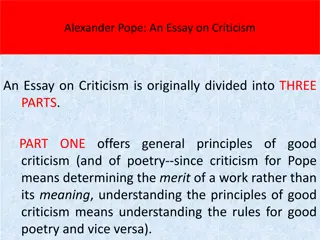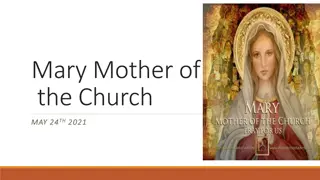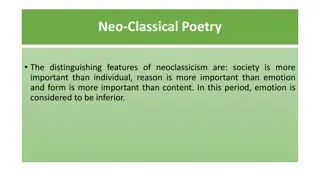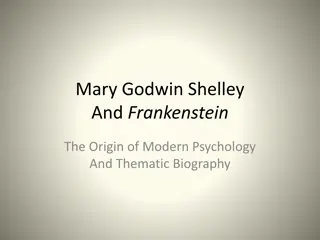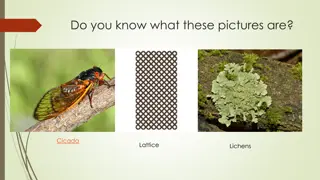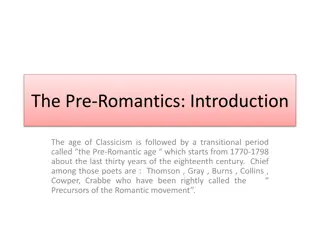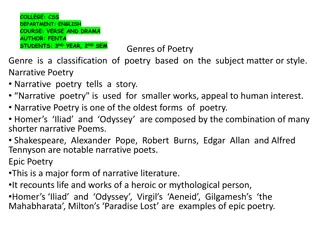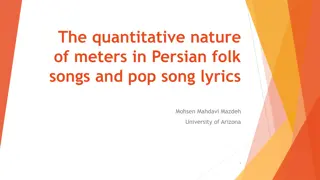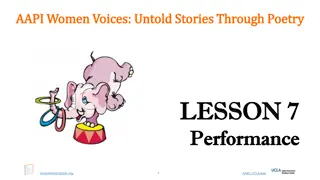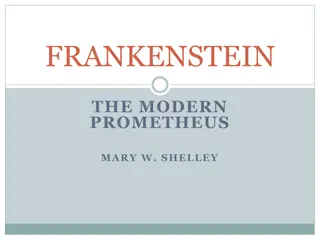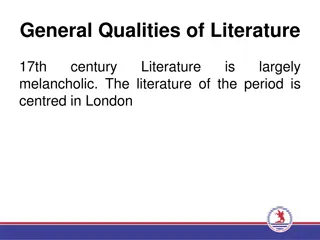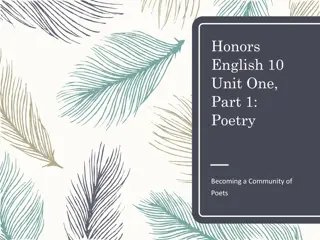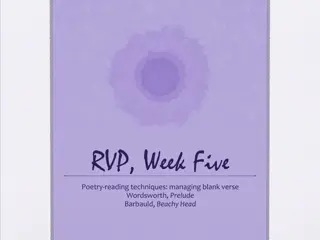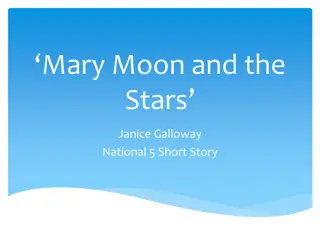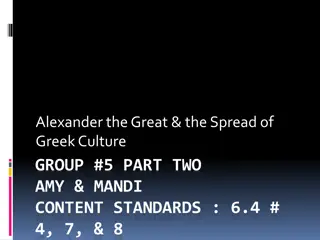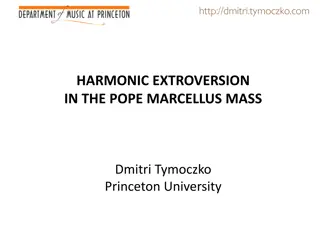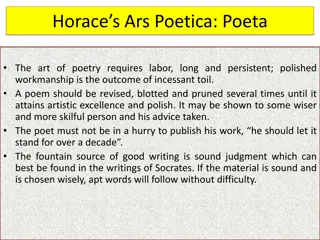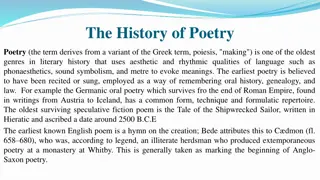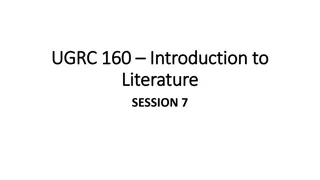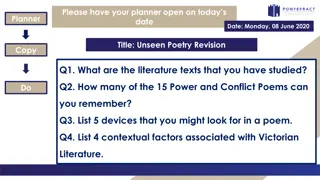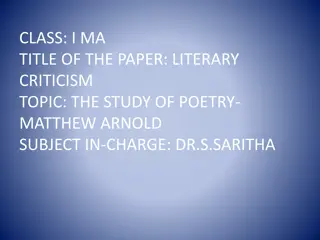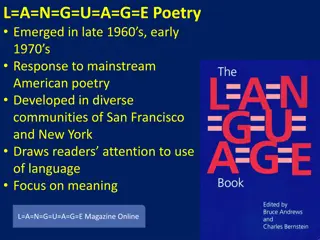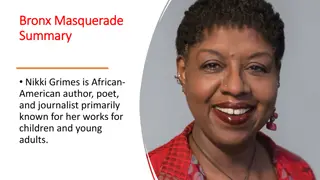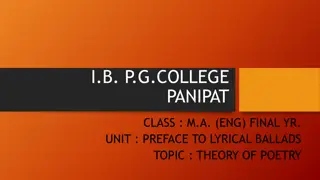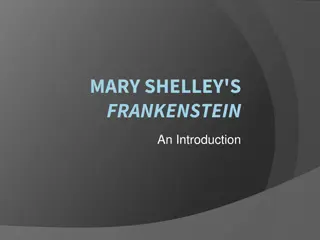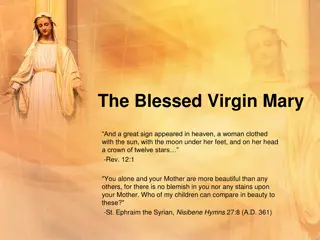Romantic Poetry Exploration: Mary Robinson and Alexander Pope
Delve into the world of Romantic poetry with works by Mary Robinson and Alexander Pope. Robinson's evocative verses in "Sappho and Phaon" capture the depths of love and despair, while Pope's translation of Ovid's "Heroides" reflects on themes of unrequited passion and poetic expression. Explore the emotional landscapes painted by these renowned poets in this captivating journey through love, loss, and yearning.
Download Presentation

Please find below an Image/Link to download the presentation.
The content on the website is provided AS IS for your information and personal use only. It may not be sold, licensed, or shared on other websites without obtaining consent from the author. Download presentation by click this link. If you encounter any issues during the download, it is possible that the publisher has removed the file from their server.
E N D
Presentation Transcript
Mary Robinson (1757?-1800), Sappho and Phaon 24 O THOU! meek Orb! that stealing o'er the dale Cheer'st with thy modest beams the noon of night! On the smooth lake diffusing silv'ry light, Sublimely still, and beautifully pale! What can thy cool and placid eye avail, Where fierce despair absorbs the mental sight, While inbred glooms the vagrant thoughts invite, To tempt the gulph where howling fiends assail? O, Night! all nature owns thy temper'd pow'r; Thy solemn pause, thy dews, thy pensive beam; Thy sweet breath whisp'ring the moonlight bow'r, While fainting flow'rets kiss the wand'ring stream! Yet, vain is ev'ry charm! and vain the hour, That brings to madd'ning love, no soothing dream! (1796)
from Ovids (43 BCE17 CE) Heroides (19 BCE?) Alexander Pope s translation (1707/1712) 1 Say, lovely youth, that dost my heart command, Can Phaon's eyes forget his Sappho's hand? Must then her name the wretched writer prove, To thy remembrance lost, as to thy love? Ask not the cause that I new numbers choose, The Lute neglected, and the Lyric muse; Love taught my tears in sadder notes to flow, And tun'd my heart to Elegies of woe, I burn, I burn, as when thro' ripen'd corn By driving winds the spreading flames are borne! Phaon to Aetna's scorching fields retires, While I consume with more than Aetna's fires! No more my soul a charm in music finds, Music has charms alone for peaceful minds. Soft scenes of solitude no more can please, Love enters there, and I'm my own disease. No more the Lesbian dames my passion move, Once the dear objects of my guilty love; All other loves are lost in only thine,
Heroides 2 Ah youth ungrateful to a flame like mine! Whom would not all those blooming charms surprize, Those heav'nly looks, and dear deluding eyes? The harp and bow would you like Phoebus bear, A brighter Phoebus Phaon might appear; Would you with ivy wreath your flowing hair, Not Bacchus' self with Phaon could compare: Yet Phoebus lov'd, and Bacchus felt the flame, One Daphne warm'd, and one the Cretan dame, Nymphs that in verse no more could rival me, That ev'n those Gods contend in charms with thee. The Muses teach me all their softest lays, And the wide world resounds with Sappho's praise. Tho' great Alcaeus more sublimely sings, And strikes with bolder rage the sounding strings, No less renown attends the moving lyre, Which Venus tunes, and all her loves inspire; To me what nature has in charms deny'd, Is well by wit's more lasting flames supply'd. Tho' short my stature, yet my name extends To heav'n itself, and earth's remotest ends.
Heroides 3 (end) A spring there is, whose silver waters show, Clear as a glass, the shining sands below: A flow'ry Lotos spreads its arms above, Shades all the banks, and seems itself a grove; Eternal greens the mossy margin grace, Watch'd by the sylvan Genius of the place. Here as I lay, and swell'd with tears the flood, Before my sight a wat'ry Virgin stood: She stood and cry'd, 'O you that love in vain! 'Fly hence, and seek the fair Leucadian main; 'There stands a rock, from whose impending steep 'Apollo's fane surveys the rolling deep; 'There injur'd lovers, leaping from above, 'Their flames extinguish, and forget to love. 'Deucalion once, with hopeless fury burn'd, 'In vain he lov'd, relentless Pyrrha scorn'd; 'But when from hence he plung'd into the main, 'Deucalion scorn'd, and Pyrrha lov'd in vain. Haste, Sappho, haste, from high Leucadia throw 'Thy wretched weight, nor dread the deeps below!' She spoke, and vanish'd with the voice - I rise, And silent tears fall trickling from my eyes. I go, ye Nymphs! those rocks and seas to prove; How much I fear, but ah, how much I love! I go, ye Nymphs! where furious love inspires; Let female fears submit to female fires. To rocks and seas I fly from Phaon's hate, And hope from seas and rocks a milder fate. Ye gentle gales, beneath my body blow, And softly lay me on the waves below!
Heroides 4 And thou, kind Love, my sinking limbs sustain, Spread thy soft wings, and waft me o'er the main, Nor let a Lover's death the guiltless flood profane! On Phoebus' shrine my harp I'll then bestow, And this Inscription shall be plac'd below. 'Here she who sung, to him that did inspire, 'Sappho to Phoebus consecrates her Lyre; 'What suits with Sappho, Phoebus, suits with thee; The Gift, the giver, and the God agree.' But why, alas, relentless youth, ah why To distant seas must tender Sappho fly? Thy charms than those may far more pow'rful be, And Phoebus' self is less a God to me. Ah! canst thou doom me to the rocks and sea, O far more faithless and more hard than they? Ah! canst thou rather see this tender breast Dash'd on these rocks than to thy bosom prest? This breast which once, in vain! you lik'd so well; Where Loves play'd, and where the Muses dwell. Alas! the Muses now no more inspire, Untun'd my lute, and silent is my lyre, My languid numbers have forgot to flow, And fancy sinks beneath a weight of woe.
Heroides 5 Ye Lesbian virgins, and ye Lesbian dames, Themes of my verse, and objects of my flames, No more your groves with my glad songs shall ring, No more these hands shall touch the trembling string: My Phaon's fled, and I those arts resign (Wretch that I am, to call that Phaon mine!) Return, fair youth, return, and bring along Joy to my soul, and vigour to my song: Absent from thee, the Poet's flame expires; But ah! how fiercely burn the Lover's fires! Gods! can no pray'rs, no sighs, no numbers move One savage heart, or teach it how to love? The winds my pray'rs, my sighs, my numbers bear, The flying winds have lost them all in air! Oh when, alas! shall more auspicious gales To these fond eyes restore thy welcome sails? If you return - ah why these long delays? Poor Sappho dies while careless Phaon stays. O launch thy bark, secure of prosp'rous gales; Cupid for thee shall spread the swelling gales; If you will fly - (yet ah! what cause can be, Too cruel youth, that you should fly from me?) If not from Phaon I must hope for ease, Ah let me seek it from the raging seas: To raging seas unpity'd I'll remove, And either cease to live or cease to love!
Issues Poetry as expression of emotion v. excessive emotion as destructive of poetry. The poet of love abandons poetry, when actually in love. The personal (handwriting, body, unrequited love) and the impersonal (genre, mythology, suicide?, poetry?) guilty love control and self-control fame / having a name norms, expectations
Poetic traditions Augustan: Latin + British Renaissance: Petrarchan Grafting the Ovidian elegy onto the Petrarchan love sonnet Instead of a sentimental outburst, a very self-conscious and educated experiment.
Gendered lyric subjectivities From Ovid s imaginative recreation of a woman s words to Robinson s heady version of a woman talking from a masculine position. Strengths and weaknesses, empowering or domesticating the passionate female voice.
Embodied, sexual female subjects The limits of representation in Ovid, in Pope s translation, in the Petrarchan tradition All in a suicidal situation.
Aesthetics and Structure From Edmund Burke s A philosophical enquiry into the origin of our ideas of the sublime and beautiful (1757) For sublime objects are vast in their dimensions, beautiful ones comparatively small: beauty should be smooth and polished; the great, rugged and negligent; beauty should shun the right line, yet deviate from it insensibly; the great in many cases loves the right line, and when it deviates it often makes a strong deviation: beauty should not be obscure; the great ought to be dark and gloomy: beauty should be light and delicate; the great ought to be solid, and even massive.
Historical Chronology 1 (Based on Wu) 1773 - Boston Tea Party 1776 -American Declaration of Independence 1787 - The Society for the Purpose of Effecting the Abolition of the Slave Trade established in London 1787 -American Constitution drafted and signed 1788 - George III suffers mental collapse 1789 - Storming of the Bastille 1789 - Price addresses the London Revolution Society 1790 - The Og rebellion in San Domingo 1791 -Anti-Dissenter riots in Birmingham during which Joseph Priestley s house is burned down by Church-and-King mobs 1791 - Slave Riots in San Domingo 1791 - United Irishmen founded by Wolfe Tone in Belfast to fight for Irish nationalism 1792 - Paine charged with sedition 1792 - September Massacres of royalists and other prisoners in Paris 1792 - Robespierre elected to the National Assembly 1793 - Louis XVI executed Britain declares war
Historical Chronology 2 1793 - Marat murdered in his bath by Charlotte Corday, heralding the Terror 1793 - Marie Antoinette Executed 1794 - Robespierre executed; end of the Terror 1794 - Treason trials begin in London with the trial of Thomas Hardy 1796 - Napoleon commands Italian campaign, defeating Austrians 1798 - Uprising of the United Irishmen 1801 - Toussaint L Ouverture takes command of Haiti, liberates black slaves 1805 - Emmet leads an uprising in Ireland which fails due to lack of French support 1805 - Battle of Trafalgar, Nelson mortally wounded 1805 - Napoleon defeats Russian and Austrian armies at Austerlitz 1807 -Abolition Act receives royal assent, abolishing the slave trade
Historial Chronology 3 1811 - Prince of Wales declared Regent, his father having been recognized as insane 1811 - First Luddite riots in Nottingham 1812 -Assassination of the Prime Minister, Spencer Perceval 1812 -America declares war on Britain 1812 - Napoleon enters Moscow 1814 - Napoleon defeated at Toulouse; exiled to Elba 1815 - Napoleon escapes from Elba 1815 - Napoleon defeated at Waterloo; exiled to Saint Helena in August 1817 - William Hone (radical publisher) tried for publishing blasphemous parodies 1819 - Peterloo Massacre takes place, St Peter s Fields, Manchester 1819 - Trial of Richard Carlile, radical publisher 1828 - Repeal of Test and Corporation Acts that kept non-Anglicans from holding office 1829 - Catholic Relief Act 1832 - Reform Bill receives royal assent 1833 - Emancipation Act receives its final reading, abolishing slavery in British colonies
Revolution After sharing in the benefits of one Revolution [of 1688], I have been spared to be a witness to two other Revolutions, both glorious. And now, methinks, I see the ardor for liberty catching and spreading, a general amendment beginning in human affairs, the dominion of kings changed for the dominion of laws, and the dominion of priests giving way to the dominion of reason and conscience. Be encouraged all ye friends of freedom and writers in its defence . . . Behold the light you have struck out, after setting America free, reflected to France and there kindled into a blaze that lays despotism in ashes and warms and illuminates Europe! (Richard Price, Discourse on the Love of our Country, 1789) Old things seemed passing away, and nothing was dreamt of but the regeneration of the human race (Robert Southey, Correspondence) Bliss in that dawn to be alive (Wordsworth, The Prelude, Book X)
Pamphlets 1 But the age of chivalry is gone. That of sophisters, economists; and calculators has succeeded; and the glory of Europe is extinguished forever. [ ] THIS mixed system of opinion and sentiment had its origin in the ancient chivalry; and the principle, though varied in its appearance by the varying state of human affairs, subsisted and influenced through a long succession of generations even to the time we live in. If it should ever be totally extinguished, the loss I fear will be great. It is this which has given its character to modern Europe. But now all is to be changed. All the pleasing illusions which made power gentle and obedience liberal, which harmonized the different shades of life, and which, by a bland assimilation, incorporated into politics the sentiments which beautify and soften private society, are to be dissolved by this new conquering empire of light and reason. All the decent drapery of life is to be rudely torn off. All the super-added ideas, furnished from the wardrobe of a moral imagination, which the heart owns and the understanding ratifies as necessary to cover the defects of our naked, shivering nature, and to raise it to dignity in our own estimation, are to be exploded as a ridiculous, absurd, and antiquated fashion. (Edmund Burke, Reflections on the Revolution in France, 1790)
Pamphlets 2 Mary Wollstonecraft s Vindication of the Rights of Men (1790) and A Vindication of the Rights of Woman (1792) William Godwin s Enquiry Concerning Political Justice (1793) Catherine Graham s Observations on the Reflections (1790) James Mackintosh s Vindiciae Gallicae (1791) Joseph Priestley s Letters to the Right Hon. Edmund Burke (1791) John Thelwall s Sober Reflections (1796) Coleridge s Conciones ad Populum (1795) Wordsworth s (unpublished) Letter to the Bishop of Llandaff (1793) Thomas Paine s Rights of Man, published in two parts in 1791 and 1792. [most accessible defense of Enlightenment concept of general human rights]
Repression May 1792, the same month in which the guillotine was used in Paris for the first time, George III issued a Proclamation against Seditious Writings (used throughout the 1790s, against booksellers, writers and other radical activists) February 1793, declaration of war between Britain and France, after which time democratic sympathies of any kind were liable to be interpreted as traitorous as well as seditious. May 1794, suspension of Habeas Corpus, then Treason Trials, in which 12 leading London radicals arrested and charged with High Treason Habeas Corpus was again suspended in 1798, and further restrictions on the right of assembly and the freedom of speech were imposed by the Two Acts of 1795 and the SixActs of 1799 The radicals became steadily more isolated as government repression continued and the war with Revolutionary France turned more and more people away from politics towards the patriotic defence of the realm.
Richard Polwhele, The unsex'd females 1 A female band despising NATURE's law, As "proud defiance" flashes from their arms, And vengeance smothers all their softer charms. I shudder at the new unpictur'd scene, Where unsex'd woman vaunts the imperious mien; Where girls, affecting to dismiss the heart, Invoke the Proteus of petrific art; With equal ease, in body or in mind, To Gallic freaks or Gallic faith resign'd The unvalued store from FANCY, FEELING drew; Won, from the grasp of woe, the roseate hours, Cheer'd life's dim vale, and strew'd the grave with flowers. [Page 12]But lo! where, pale amidst the wild, she draws Each precept cold from sceptic Reason's vase; Pours with rash arm the turbid stream along, And in the foaming torrent whelms the throng. Ah! once the female Muse, to NATURE true,
Richard Polwhele, The unsex'd females 2 See Wollstonecraft, whom no decorum checks, Arise, the intrepid champion of her sex; O'er humbled man assert the sovereign claim, And slight the timid blush of virgin fame. "Go, go (she cries) ye tribes of melting maids, "Go, screen your softness in sequester'd shades; "With plaintive whispers woo the unconscious grove, "And feebly perish, as depis'd ye love. "What tho' the fine Romances of Rousseau "Bid the flame flutter, and the bosom glow;[ ] "No more by weakness winning fond regard; "Nor eyes, that sparkle from their blushes, roll, "Nor catch the languors of the sick'ning soul, "Nor the quick flutter, nor the coy reserve, [ ] "Blend mental energy with Passion's fire, "Surpass their rivals in the powers of mind "And vindicate the Rights of Womankind."
Richard Polwhele, The unsex'd females 3 Fn. "Nature is the grand basis of all laws human and divine: and the woman, who has no regard to nature, either in the decoration of her person, or the culture of her mind, will soon 'walk after the flesh, in the lust of uncleanness, and despise government" Lady Macbeth: Come, you spirits That tend on mortal thoughts, unsex me here, And fill me from the crown to the toe top-full Of direst cruelty! make thick my blood; Stop up the access and passage to remorse, That no compunctious visitings of nature Shake my fell purpose, nor keep peace between The effect and it! Come to my woman's breasts, And take my milk for gall, you murdering ministers, Wherever in your sightless substances You wait on nature's mischief! (V.1 [regicide])
Mary Wollstonecraft, A Vindication of the Rights of Woman (1792) Inspired by her indignation at the fact that women were explicitly being excluded from the compulsory schooling offered to men in France. - Who made man the exclusive judge, she asked, if woman partake with him the gift of reason? First principle that there was only one standard of human virtue which must be the same for men and women. Argued for the institutional and legal changes which would follow from the recognition of women s rationality and moral autonomy: education which combined intellectual training with useful skills; the need for an end to the sexual double standard; reform of marriage; admission of women to fields of study and of paid employment, which would allow them; economic independence (medicine and business as possible professional pursuits, politics and history for intellectual and moral improvement). their duties as mothers provided the basis of their claims to be independent citizens
Mary Wollstonecraft, A Vindication of the Rights of Woman (1792) A philosophical essay against the social, political, and economic marginalization of women. At a time when the question of the rights of man was being debated in France and the US. The difference between men and women is not natural (ideology) but learned. Education should be changed, so that instead of making women sentimental and childlike (often domestic slaves), they become fully rational agents. Criticism: universal Enlightenment ideal of Reason.
Education THE Enlightenment project: We have reason to conclude, that great Care is to be had of the forming Children s Minds, and giving them that seasoning early, which shall influence their Lives always after. (Locke) + debate about perfectibility, natural goodness BUT: Rousseau s Emile (1762) Hannah More: Is it not a fundamental error to consider children as innocent beings, whose little weaknesses may perhaps want some correction, rather than as beings who bring into the world a corrupt nature and evil dispositions, which it should be the great end of education to rectify. Hannah More: the man whose happiness she is one day to make, whose family she is to govern, and whose children she is to educate . . . he will seek for her in the bosom of retirement, in the practice of every domestic virtue . . . to embellish the narrow but charming circle of family delights Catherine Cappe: cultivation of social and pious affections, gentleness of temper and resignation to the will of God [were] as important to the female character in the lowest as well as the highest forms of life Education: limiting spheres of action + beginning to provide the schooling to expand those limits; both with regard to gender and class
Education 2 The Brougham Report in 1819 estimated that about 30 per cent of children had a little schooling. The Children s Employment Commission of 1833 concluded that only 10 per cent of children had satisfactory schooling, whereas 40 per cent had none at all. lite and middling women s life stories confirm a high incidence of home education, showing that it was often preferred even when schools were available. With time, competence, and interest, mothers taught daughters themselves, but the period also saw the rise of the governess as an important part of the educational structure. One study of English women showed that 60 per cent of middle-class girls were educated at home, and the trend is similarly pronounced among girls of the lite
Educational Reform embedded in a wider European debate about women s rights; not all critics were liberals, and the strong evangelical belief in virtue played an important role. Scots educationalist, Elizabeth Hamilton: to be virtuous, women needed to be educated in morals rather than manners , Maria Edgeworth defended the right of women to useful knowledge, including the sciences, rather than be kept in Turkish Ignorance , Hannah More and the radical Mary Wollstonecraft condemned what More termed, this phrenzy of accomplishments . More: to make girls into good daughters, good wives, good mistresses, good members of society, good Christians .
Further Education Within women s educational history, the foundation of Queen s College, London, in 1848, is seen as a landmark. It provided a foundation to give governesses and teachers a better educational grounding, thus marking the Historians have looked for institutions that gave qualifications and access to professional standing. In fact, a range of training and educational genres existed, including midwifery training, teacher training , and liberal arts or scientific studies, to which numerous women turned in their efforts at improvement . Such opportunities could be structurally very casual, relying upon improving leisure activities. Lecture series were also offered in many British towns. Most were open to women; some even offered women concessions. In 1803, it was noted: Even some ladies talk with facility about oxygen . . . hydrogen and the carbonic acid. Some of these series were clearly associated with the universities. Lectures on Experimental Philosophy at Oxford included women from 1710. Lectures at University College, London, were open to women from its foundation in 1825. The Royal Institution in London admitted women from its inception (1799).
Marriage and Family Our knowledge of women in the past has long been focused on their familial roles and relationships. Women s familial and marital identity was framed by a combination of legal, religious, medical, and popular ideas patriarchal, but companionate Men s legal, social, and political power over women was located, as well as learned, it was argued, within the home. Prescriptive literature expounded a husband s authority over his wife and delineated the strict hierarchies to be maintained within households between husbands and wives, parents and children, and masters and their servants. At their wedding ceremonies, women in England and Wales effectively kissed goodbye to their status as individuals, as husbands subsumed their legal rights according to the law of coverture. Theoretically, women and everything they owned, became the property of their husbands. In his 1765 Commentaries on the Laws of England, Sir William Blackstone declared: By marriage, the husband and wife are one person in law: that is, the very being, or legal existence of the woman is suspended during the marriage, or at least is incorporated and consolidated into that of the husband . . . [her property] becomes absolutely her husband s which at his death he may leave entirely from her BUT Recourse to equity and ecclesiastical law, and the use of marriage settlements, allowed women of all social classes to retain some control over their property.
Marriage and Family 2 During the eighteenth century, people were marrying earlier. They were also having more children than at any time before, both inside and outside of marriage. In the first half of the century, the mean age at first marriage was 27.5 years for men and 26.2 years for women; by mid-century, it had dropped to 26.4 for men and 23.4 for women The significant rise in population during the eighteenth century was due to an increase in fertility precipitated by this decline in the age of marriage Until the twentieth century there was no consensus between the state, church, and popular opinion as to how marriage should be defined Before the Marriage Act of 1753 there was little consensus as to what constituted a legal marriage. For centuries a gulf had existed between the ways in which the lite and poor had married. The wealthy would celebrate their unions in public, often in church, after declaring the banns and buying a license. The poor would marry in much more informal circumstances, often using verbal contracts and folklore customs familiar to the local community co-dependency best describes most marriages.
Marriage and Family By the early nineteenth century, as more women resisted the power of their spouses, public opinion and the law increasingly demanded that husbands treat their wives with humanity. Men s violence towards women came to be interpreted as the neglect of male duties. Nineteenth-century notions of respectability defined such behaviour as unmanly. The struggle for a mother s rights over her children was partly resolved in the passage of the Infant Custody Act of 1839, which stipulated that a mother of legitimate children had legal rights over her offspring until they reached seven years of age feminist demands for a wife s control over her own property were not met until the passage of the Married Women s Property Acts in 1870 and 1886
Parents and Children The duties of mothers and fathers were fundamentally gendered and differed ideologically as well as in practice. Theological, medical, social, and legal understandings of women were intimately bound up with their capacity to bear children. A woman s reproductive status defined her and motherhood was deemed her natural role. The physical relationship between women and their children explained why maternal affection was deemed to be stronger than the love of fathers for their offspring The emergence of modernity produced a trans formation not only in affective relations between lovers and marriage partners, but also between parents and their children. Motherhood as an invention of capitalism, suggested that the lite s practice of wet- nursing children and the poor s propensity to abandon theirs, proved that early modern mothers and fathers felt little love for their offspring Only in the eighteenth century did childhood come to be acknowledged as a separate stage in the life cycle and children valued.
Parents and Children The staggeringly high rate of infant mortality up until the mid-1700s had supposedly encouraged parents to make less investment in the lives of their newborns and even until the nineteenth century, it has been argued, indifference towards infant life and death was common The decline in infant mortality, deemed to be a direct result of the increase in breastfeeding among the aristocracy and bourgeoisie, as well as a philosophical reassessment of the role of mothers within the family Rousseau, in particular, has been credited with the revaluation of maternity. Many became convinced that women had a vital role to play in the education of their children and the future citizens. Good mothering and responsible childrearing became women s social duty Most wives spent almost their entire married lives pregnant or caring for children. Women on average bore 6 7 live children
Thomas Laqueur, Making Sex: Body and Gender from the Greeks to Freud (1992) Not only did the idea of sex not always exist, but before about 1800 in Europe bodies were seen in radically different ways. Far from our ancestors living in a world in which sex was a fundamental reality given by biology, the primary reality for them was a divine order, an order in which bodies were oddly insubstantial things. Bodies in pre-Enlightenment accounts are mutable indices of a metaphysical reality.
Laqueur 2 Rather than bodily morphology providing evidence of an underlying biological reality, it merely makes vivid and more palpable a hierarchy of heat and perfection that is in itself not available to the senses . The one-sex model described woman as a lesser version of man. Men would, in Christian theology, have been placed below the diverse orders of the angels, but above the whole of the animal kingdom. Fundamental polarity between the sexes based upon discoverable biological differences: substantial horizontal difference, instead of a vertical one of degree
Laqueur 3 What is also marked after 1800 is that bodies are being thought of in a different way, as the foundation and guarantor of particular sorts of social arrangements. no one was much interested in looking for evidence of two distinct sexes until such differences became politically important . Sex is a motivated invention born of gender: inextricable link between the ways in which bodies are imagined and the political and cultural imperatives of gender. The body does not automatically give itself to be interpreted in this or that particular way: Two sexes are not the necessary, natural consequence of corporeal difference. Nor, for that matter, is one sex .
The sexual body Aristotle, Hippocrates, and Galen Asaw the body consisting of four humours or fluids: blood, choler, black bile, and phlegm. And each humour was related to two qualities hot or cold and moist or dry of which the most perfect was hot and dry [men]. Allowed for great variety and mutability within and between bodies, rather than simply absolutes. Male and female bodies were based on the same model of physiology. For example, in trying to maintain a balance of the humours, they purged excess fluids in very similar ways. According to the Hippocratic and Galenic two-seed theories, both women and men were believed to emit seed and excess fluid at the point of orgasm. This is not to say that women and men were the same. Differences did exist, but these originated from the different balance of the humours in male and female bodies. This essentially physiological model determined how bodies were built. Men s and women s genitals were structurally and functionally the same, and the same vocabulary was used for many body parts. For example, the word testicle was used for the organs which contained the seed in both women and men: Women have testicles or stones, as have the men , wrote John Marten in 1708. Illustrations of women s reproductive organs presented the uterus and vagina as one long and enclosed sheath, which looked remarkably similar to depictions of the penis.
Female genitalia Galen, (200 A.D.) "All the parts, then, that men have, women have too, the difference between them lying in only one thing, [ ] namely, that in women the parts are within [the body], whereas in men they are outside, in the region called the perineum. Illustrations of women s reproductive organs presented the uterus and vagina as one long and enclosed sheath, which looked remarkably similar to depictions of the penis. Illustration byAndreas Vesalius (1514-1664)
Implications of the two-sex system In the Enlightenment, the body was increasingly used as evidence that difference was immutable and permanent: The humoral system declined in popularity and anatomical sexual differences were stressed. From 1700, the term vagina was used in vernacular medical texts to describe the cavity that had previously not had its own name; later in the eighteenth century, the term ovary appeared When depicted visually, the uterus and vagina were often splayed open, lessening the parallel with the penis. All images of skeletons had once been based on male corpses, but images of female skeletons with a narrower ribcage, wider pelvis, and smaller skull reflected the assumptions these men Muscles were shown using male models, nerves using female models female skeletons often displayed flowing hair and pearl necklaces, and reclined in passive poses the sperm was a hungry, active cell, which dispelled energy; the ovum a quiescent cell, which stored energy the female orgasm was relegated to the periphery of human physiology : women were reimagined as sexually passive
Religion There were two established and legally co-equal churches in Britain: the Church of England (Anglican), established in Wales and Ireland, as well as in England, and the Church of Scotland (Presbyterian) in Scotland. Neither church allowed women to be ordained, to preach, or, in the case of the Church of Scotland, to be elders. In England, Wales, and Ireland holders of civic offices had to take communion in the Church of England at least once a year, and students at Oxford, Cambridge, and Trinity College Dublin had to assent to the Thirty-Nine Articles before they matriculated. However, the Toleration Act of 1689 gave freedom of worship to the main Dissenting denominations (Presbyterians, Independents, Baptists, and Quakers), though the non- Trinitarian Unitarians had to wait until 1813 for legal recognition of their right to worship. Roman Catholics were expressly excluded from the Act. The major eighteenth-century religious development was the Evangelical revival, which began in the 1730s. A second wave at the end of the century saw Methodism become a separate denomination and the EvangelicalAnglican Clapham sect become prominent in the movement for the abolition of the slave trade. Christian missionaries all over the Empire
Women and Religion The Genesis account of creation which proclaimed woman s responsibility for the fall of man, and the New Testament prohibitions of women s preaching (I Corinthians 14:34 and I Timothy 2:9 15) were generally taken at face value, by women as well as men 1 Corinthians 14:34-35 King James Version (KJV): 34Let your women keep silence in the churches: for it is not permitted unto them to speak; but they are commanded to be under obedience as also saith the law. And if they will learn any thing, let them ask their husbands at home: for it is a shame for women to speak in the church. I Timothy 2:11 15 : Let the woman learn in silence with all subjectionBut I suffer not a woman to teach, nor to usurp authority over the man, but to be in silence.For Adam was first formed, then Eve.And Adam was not deceived, but the woman being deceived was in the transgression.Notwithstanding she shall be saved in childbearing, if they continue in faith and charity and holiness with sobriety. BUT Galatians 3:28 King James Version (KJV) There is neither Jew nor Greek, there is neither bond nor free, there is neither male nor female: for ye are all one in Christ Jesus. The Bible also gave women a language to validate their callings. The title mother in Israel was given to the Old Testament prophetess, Deborah (Judges 5:7), and in the eighteenth and nineteenth centuries the title provided a vindication for those women who sought a public role or assumed positions of leadership Religion provided women with opportunities denied them in secular society.
Women and Religion 2 Some historians have claimed that Christianity become increasingly feminized in this period and not only because women outnumbered men in many denominations. The eighteenth-century fusion of Methodist enthusiasm with the secular cult of sensibility privileged deeply felt personal experience above academic rationality. The new religion of the heart was exemplified in the vivid language of the Methodist servant, Mary Barnard: I think the Lord has washed my soul as clean as the stones in the brook. William Wilberforce (Evangelical) believed that the female sex possessed a more favourable disposition to religion , which made women the medium of our intercourse with the heavenly world, the faithful repositories of the religious principle, for the benefit both of the present and of the rising generation Many men were prepared to concede women s spiritual superiority at the same time as they denied them political or intellectual equality [~domesticity]. On the other hand, many devout, energetic, and competent women mainly middle class engaged in a variety of good works, which could be justified as extensions of their caring roles as wives and mothers. philanthropic women crossed the boundaries between the masculine public and the feminine private spheres, and, in doing so, they set up what might be described as a third sphere of creative and flexible interaction between the domestic hearth and the world of business and politics
Women and Religion 3 Mary Astell (1661 1731), now recognized as the first English feminist, derived her inspiration from a fusion of the philosophy of Descartes, the spirituality of high Anglicanism, and Christian Platonism. In her Serious Proposal to the Ladies (1694 7), she argued that women should be taken seriously as rational beings, and, envisaged a Protestant nunnery an independent space where they could cultivate their intellects as well as their souls. Susanna Wesley (1670 1742), mother of John and Charles [methodism], began holding meetings in her house for prayer and sermon-reading, which were attended by several hundred local townspeople. Recognizing her success, her husband over-rode the objections of his curate and allowed her to continue with her meetings. Of all the dissenting sects, the Society of Friends gave the greatest scope for female participation, and the high literacy rate among Quaker women is a tribute to their status in the movement, Its founder, George Fox (1624-91), had allowed women to preach, but for the majority of Quaker women it was the Women s Yearly Meeting, set up as a properly constituted Meeting in 1784, which gave them their most important role in the Society The Rational Dissenters and their successors, the Unitarians, were committed to liberalizing society, expanding education, and freeing the mind from the shackles of religious doctrine. The writer and educator, Anna Barbauld (1743 1825), represented the conservative strand of Rational Dissent, Mary Wollstonecraft (1759 97), the more radical. Wollstonecraft learned her politics from Richard Price; her works were published by Joseph Johnson, the official publisher of the Rational Dissenters.
Women and work the idea that the period 1700 1850 witnessed both a significant narrowing in opportunities for women s work and a lowering in its status is still widely held, explained typically by the decline of the family economy in the eighteenth century and argued that women were both economically and socially marginalized by industrial development It has been claimed that the industrial revolution helped to promote separate spheres ideology, and with it such developments as restrictive labour practices and campaigns for the family wage, which served to redefine and revitalize patriarchal forces. Farm labour in Britain has traditionally been divided into men s and women s work, with women who laboured for pay typically receiving one third to one-half of a male wage: suggesting a long-standing presumption that female work was less valuable than men s. Like female agricultural workers, women miners appear to have offended middle-class sensibilities by virtue of their physical appearance and dress Even so, women commonly worked underground in mining, in coalmines, most women were employed as bearers, carrying coal from the face to the surface. Women and children were employed in manufacturing in disproportionate numbers. It frequently centred around textiles and involved women working as spinners, silk throwers, lace-makers, and framework knitters
Women and Work 2 When we talk of industry in the eighteenth and early nineteenth centuries , claims Berg, we are talking of a largely female workforce. Much of this workforce was poorly paid and doing work deemed less skilled than men s. Organized action against women workers could involve violence. In 1819, several unemployed male spinners attacked a group of women spinners newly employed at the Broomward cotton mills near Glasgow. Service occupations, and domestic service in particular, were dominated by women workers and were by far the greatest employers of women during our period. Prostitution was generally entered into by young, poor women, women who worked as servants, needlewomen, and engaged in other casual work, often supplemented their income in this way. the fact that many contemporary estimates are extremely high had more to do with middle-class moral panic than accurate social measurements. Middle-class women engaged in trade. Middling women were expected to withdraw from the world of work as the eighteenth century progressed BUT perhaps one-third of women of property ran a business in the early eighteenth century, which constituted some 5 10 per cent of all businesses in the capital at that time. This suggests, rather than a decline, some consistency in terms of middling women s involvement in the world of work.
Women and Work 3 The professions were male-dominated during our period, but women were not totally excluded from the professional ranks during the eighteenth and nineteenth centuries: women also earned money as authors and painters Women did perform medical care for money, but this was often as midwives, nurses, wet nurses, and druggists, dentists, surgeons, and occulists in England until the late eighteenth century Teaching was one of the few professions open to women that expanded between 1700 and 1850, because it was not regarded as a profession and as such was largely unregulated There is no doubt that ideas about gender and about what constituted men s work and women s work had a great impact on the female labour force during our period. Increasingly, male identity was shaped by work, while the feminine was associated with domesticity. Yet it was not the case than men and women always performed separate jobs. Men s and women s work evidently overlapped in areas such as shopkeeping, weaving, and innkeeping, in towns with one dominant industry such as the mill towns of Oldham and Bury and at certain times, such as when labour was in short supply or during harvest in rural areas. Although women were increasingly associated with the domestic and the maternal in literary sources, the evidence that this constrained their working patterns is not conclusive.
Recommended general works on women, poetry and romanticism Barker, Hannah and Elaine Chalus. Eds. Women s History: Britain, 1700 1850. London and New York: Routledge, 2005. Gerrard, Christine. Ed. A Companion to Eighteenth-Century Poetry. Oxford: Blackwell, 2006. Labbe, Jacqueline M. Ed. The History of British Women s Writing, 1750 1830. Basingstoke: Palgrave Macmillan, 2010. Mahoney, Charles. Ed. A Companion to Romantic Poetry. Oxford: Wiley-Blackwell, 2011. McCalman, Iain. Ed. An Oxford Companion to the Romantic Age. British Culture 1776-1832. Oxford: Oxford UP, 1999. Shattock, Joanne. Women and Literature in Britain 1800-1900. Cambridge: Cambridge UP, 2001. Wu, Duncan. Ed. A Companion to Romanticism. Oxford: Blackwell, 1999. Wu, Duncan. Ed. Romanticism: An Anthology. Chichester: Wiley-Blackwell, 2012. Wu, Duncan. Ed. Romantic Women Poets: An Anthology. Oxford: Blackwell, 1997.



